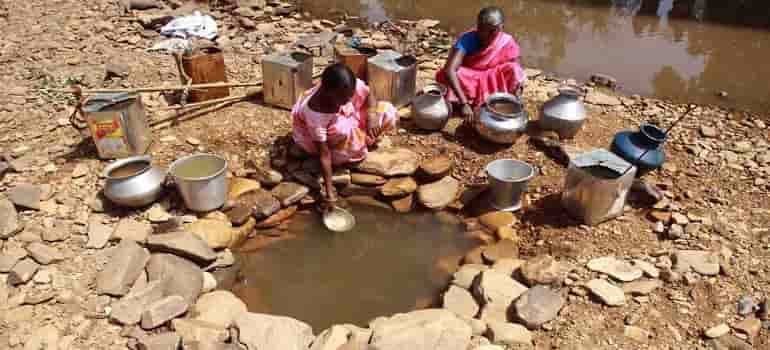
As we are at the outset of another summer season, do we remember the agony of the past seasons caused because of water scarcity? Depleting water resources in the country are creating constant stress and every year many cities, towns and villages are becoming parched. Last year the tourist town of Shimla was in news not for its tourism or beauty but for acute water crisis. The situation was so grave that most of the town was getting water once in eight days. Locals protested against tourism and it led to around 35% decline in tourism. This is not the only example and many other cities have seen the implications of water scarcity and there is lot more to come in future. A report by the NITI Aayog states that the capital, Delhi is predicted to hit ‘zero day’ by 2020 when it water supply will run out. Another study by the National Geophysical Research Institute analyzed that in the world, the largest depletion of groundwater is happening in north India and Delhi is the epicenter of this.
NITI Aayog report also mentions that including Delhi 21 cities are expected to exhaust their groundwater by 2020. This is an alarming situation for the country and major cities of the country which are economic hub.
These available facts supported by anecdotes we have for each summer from various parts of country are enough evidences for taking corrective measures sooner than later.
Myopic vision for developing policies around water has already led to mis-management of the resources. Water is often used as vote bank and free supplies or low price is the financial incentive given to attract voters. There have been other policies where electricity was given free which led to injudicious exploitation of groundwater. Groundwater has been severely impacted and one of the reasons is because this common property resource is qualified as private property due to land rights.
Even surface water sources come with their own set of challenges. Most of the perennial rivers originating from snow and ice clad mountains are vulnerable because of changing climate. Pollution in the rivers is so high that they need intensive treatment before use. Report by NITI Aayog substantiates this and the estimates suggest that around 70% of India’s water is contaminated.
Faulty policies, mis-management of resource, increasing demand, poor infrastructure and limited incentives to conserve and efficiently use water has jeopardized this sector badly. India is progressing on development path but growing water crisis in the country will stall the development progress. As water forms the intricate nexus with most of the other important resources like energy, food, land, and climate change, any stress on water will directly affect these sectors. NITI Aayog report states that water scarcity would account for a loss of around 6% in India’s GDP.
ALSO READ: Kerosene-Solar Subsidy Swap: A missed opportunity and a new imperative
Every summer is a forgotten story. Monsoon rainfall is not efficiently stored and used, creating despair during months of peak demand. Somewhere, there is a need to understand the sustainable management of water resources. Some of the easy, do-able measures include water conservation interventions such as rainwater harvesting which could help to store and use rainwater for various purposes. Both urban and rural areas of the country can harvest the rainwater and use it during the dry spells and this could be implemented by both suppliers and users. Other water demand management strategies that could be adopted by the users to minimize the water wastage include use of water efficient fixtures and faucets in households. For industries, there are many strategies of efficient water use and in agriculture sector interventions like micro-irrigation system, changing cropping pattern from high water intensive to low water intensive crops are proving to be a turning point. The same NITI Aayog report mentions about some of the states like Rajasthan, Jharkhand that are improving the scores of their Composite Water Management Index over the years. The industrial sector is taking some of the exemplary water conservation work under CSR mandate and is aiming to become water neutral or water positive. These initiatives in reality lay the right path for development, than the earlier traversed road of rampant over exploitation of natural resources. From water intensive to water neutral is the new course set for the industries. Similarly, agriculture sector needs to be more efficient being the largest water consumer in the country. MIS and other agricultural practices like mulching, intermittent irrigation of paddy and many other interventions exist for reducing the water consumption but lack of mandatory rules and regulations dampens the effectiveness of these interventions.
All the stakeholders of water sector including policy makers, users, and practitioners have to take the much needed U-turn now and have to dwell on traditional wisdom of water management thereby minimizing the wastage and conserving the pristine resource. There are many interventions that are easy to take up at individual level, but a push from policy front could accelerate the pace as the time is now the most challenging factor.
These small steps taken collectively could help India to take a U-turn in water sector and long leap on development pathway.
AUTHOR

Sonia Grover
Sonia Grover is working as Associate Fellow in the Water Resources Division of The Energy and Resources Institute (TERI), New Delhi
She obtained her master’s degree in Water Resources Management from TERI University. She is working on various aspects related to integrated water resources management, water–energy nexus, water conservation, hydrological modelling, and impacts of climate change. She has expertise in carrying out water demand estimation for various sectors, assessment of baseline of water use, hydrological modelling for different watersheds and estimating water footprint along the supply chain. She has also been actively involved in Water, Sanitation, and Hygiene (WASH) related projects and has experience in carrying out participatory appraisal exercises in the field. She has led and has been the key team member of various water related projects sponsored by multilaterals, government, and corporates. She is pursuing PhD on ‘assessment of climate change impact on water availability patterns in a mountain catchment’.
Views expressed in this article are those of the author and do not necessarily reflect those of the editors or publishers.

